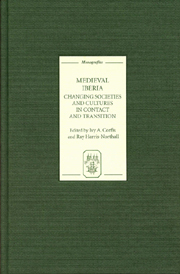Book contents
- Frontmatter
- Contents
- Acknowledgements
- Introduction
- Part 1 SOCIAL AND CULTURAL MINORITIES IN CHANGING SOCIETIES
- Part 2 CONTACT AND CONFLICT: PERSPECTIVES ON HISTORY AND CULTURE
- Part 3 TRANSMISSION OF LEARNING AND TEXTS IN CHANGING CULTURES
- Part 4 LINGUISTIC CONTACT AND CHANGE
- Perils of Speaking of Orígenes de la lengua
- Aspects of Official Language Usage in Castile and León: Latin and the Vernacular in the Early Thirteenth Century
- Considering Paradigmatic Factors in the Reduction of Old Spanish sodes > sois
- Index
Perils of Speaking of Orígenes de la lengua
from Part 4 - LINGUISTIC CONTACT AND CHANGE
Published online by Cambridge University Press: 12 September 2012
- Frontmatter
- Contents
- Acknowledgements
- Introduction
- Part 1 SOCIAL AND CULTURAL MINORITIES IN CHANGING SOCIETIES
- Part 2 CONTACT AND CONFLICT: PERSPECTIVES ON HISTORY AND CULTURE
- Part 3 TRANSMISSION OF LEARNING AND TEXTS IN CHANGING CULTURES
- Part 4 LINGUISTIC CONTACT AND CHANGE
- Perils of Speaking of Orígenes de la lengua
- Aspects of Official Language Usage in Castile and León: Latin and the Vernacular in the Early Thirteenth Century
- Considering Paradigmatic Factors in the Reduction of Old Spanish sodes > sois
- Index
Summary
Introduction
For some, one of the most fascinating aspects of Medieval Iberia is the use of language. Who spoke what, with whom, and where? What were the languages of Iberia really like at any given time? What was it that brought about what seems to have been – from our viewpoint many centuries later – a rather sudden explosion of writing for the first time in the vernacular? Were there precipitous linguistic developments at the time that might have triggered such a shift? Were the incipience and surge in vernacular writing rooted in social change?
These and many other questions like them are the turf of a wide variety of scholars, most centrally those who would describe themselves as philologists or historical linguists. Students can be fascinated by these questions as well, and scholars less engaged in problems of language history than in medieval literature or history in general can profit from gaining as clear an understanding as possible of questions revolving around language.
This brief essay stems from several years of experience in teaching a mostly undergraduate course in the evolution of Romance languages. Any student with good preparation in reading, writing, speaking and understanding at least one Romance language is welcome. With regard to language background, the heap of the bell curve of the class is typically formed of anglophone students with good non-native fluency in Spanish, and at least basic knowledge of one or more of French, Italian or Portuguese.
- Type
- Chapter
- Information
- Medieval IberiaChanging Societies and Cultures in Contact and Transition, pp. 153 - 164Publisher: Boydell & BrewerPrint publication year: 2007



